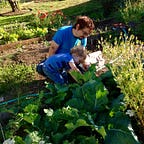Wild Edibles: Sautéed Coltsfoot is Yummy
If you’re not willing to ask, “Can I Eat That?”, you’ll never try something as delicious as sautéed coltsfoot….
If you’re hiking in the Pacific Northwest and you come across a patch of the crazy looking, broad-leaved guys above, would your first instinct be, “can I eat that”? It’s definitely become mine, which I suppose in certain circles makes me pretty weird.
That’s Petasites frigidus, “coltsfoot,” aka butterbur or arctic coltsfoot. It usually hangs out in super-mucky areas in our local forests, places where you’ll need to make a “squish” noise with your feet if you want to get close to it. Later in the summer, it puts out pretty nifty flower stalks with nice, white, fuzzy inflorescences that almost look dandelion-y. This isn’t surprising, as P. frigidus is in the same family as dandelions — Asteraceae. They’re kissing cousins!
Still, nothing about the big-ol’, pinwheel looking leaves on this guy generally shout out, “eat me!” But, if you’re of a certain mindset, you do start to wonder about the plants you walk by on a daily basis, or on a dayhike, or on a trip to the park. So you look into “wild” edibles like dandelions or lambsquarters. Then you start to realize that the “weedy” wild edibles are the tip of the iceburg, that every time you walk around in a place where there are plants, chances are that more are edible than not. Then you start reading the lit, and finding descriptions of plants like coltsfoot which you *know* you’ve seen in the local park, and now you have a new mission. It’s time to find out the answer to the question, “Can I eat that?”
Yesterday, I had the opportunity to harvest some stalks of this delightful plant. We found a fairly large patch in a local park (along with a huge forest of salmonberries, but that’s a subject for another post), and, trusty clippers in hand, I made away with a reasonable eight or so leaf stalks:
As you can see, they’re fairly substantial; a little goes a long way. I chopped them into sections and cleaned them in water and vinegar (just in case).
Finally, I chopped a clove of garlic, melted a tablespoon of clarified butter and mixed it with a teaspoon of olive oil, added them to a small sauté pan, and when the garlic was fragrant, tossed in the coltsfoot. Five minutes on medium high, tossing and stirring occasionally, salted and peppered, and the Petasites started smelling divine:
This is my favorite way to try “wild” food I haven’t tried before. A simple sauté allows the natural flavors of the plant to pop without the intrusion of other contrasting ingredients (yeah, I know I use garlic, but I’m Sicilian, so it doesn’t count). Once I have the basic flavor profile down, I can start exploring different methods of preparation and incorporation into a wider variety of dishes.
How’d they taste? If a lovely sautéed celery dish is a flank steak, coltsfoot is like a venison chop. It was delicious, “gamy,” flavorful and unique. I can see its inclusion in roasts, soups, and casseroles. It is a winner. A Winner, I Say!
I never would have known if I hadn’t started asking, “can I eat that?” at some point. Once you start asking that question, there’s an incredible new reality you’ll begin to uncover, and numerous lessons to learn about plants like Petasites frigidus. Stick around, and you’ll start asking “Can I Eat That?”, and you’ll be happier for it.
*DISCLAIMER* As an eagle-eyed reader mentions, it’s worth noting that some members of this genus contain potentially hepatotoxic compounds (bad fer yer liver) and you should avoid consuming it in mass quantities, or if you’re pregnant. In small (read: normal serving sized) amounts, it should be fine. SEE ALSO: Bracken fern.
When not studying Permaculture or drinking licorice fern and salal berry sodee-pop, Jeremy Puma writes some things and cooks some things.
